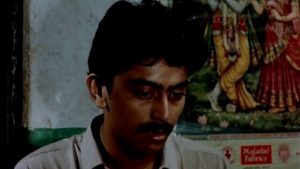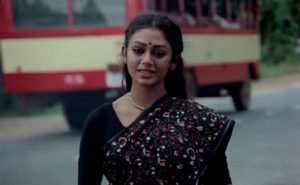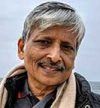Adoor Gopalakrishnan’s Anantaram (1987), his fifth film and its three preceding films have a common approach of a biography of an individual. They get deeper and deeper as we move from his second film onwards. While Kodiyettam (1978) follows the carefree Shankaran Kutty attaining maturity, in Elippathayam (1982), Unni is like a rat in a trap, caught in his feudal ways. When Sreedharan a revolutionary communist leader makes a comeback from hiding in Mukhamukham (1984), he is a defeated man much to the dismay of the people who look up to him. Anantaram, which differs from them with its narrative strategy, is Adoor’s magnum opus. Analysing it will help in understanding its import and what Adoor achieved in it.
If one attempts to write the story in brief for Anantaram, one may end up putting down its plot instead. In place of the terms, “story” and “plot”, David Bordwell uses the terminology of Russian Formalists who call them as fabula (sometimes translated as “story”) and syuzhet (usually translated as “plot”). [1] In Anantaram the fabula has to be constructed by the viewer from the syuzhet which is presented by the film. Ajayan also known as Ajayakumar (performed exceptionally well by both Sudheesh as a boy and Ashokan as a youth), the protagonist of Anantaram, tells his story in one way and as the title goes (Anantaram means ‘and then’/‘whereupon’), he tells his story once again which doesn’t have much correspondence with the previous one. There have been films such as Akira Kurosawa’s Rashomon (1950) and Tom Tykwer’s Run Lola Run (1998) having different versions or points of view of the same events. In Anantaram the two versions are told in the first-person narrative by the same person which is rather new. The English title of the film is ‘Monologue’. It is in fact a double monologue and its structure can be called as “Double monologue/ narrative in the same first-person point of view”.

In his first version, Ajayan recounts that he was an unwanted child abandoned by his mother after his birth in a hospital. The doctor in the hospital raises him as an adopted son affectionately. His extraordinary talents alienate him from others except his foster brother Balu (played with a quiet presence by Mammootty) who is studying medicine. When he grows up and goes to college, he gets estranged from Balu– a doctor now – too when he gets strangely attracted to Balu’s newly wedded wife Sumangali called Suma (performed sensuously as well as hauntingly by Shobhana). With the feeling of guilt due to that he leaves home and he is apparently driven into suicide. Ajayan comes out quite the contrary in his second version in which he is far from being a gifted child. Suma resembles Nalini (also played by Shobhana) with whom he was in love, which torments him further.
Ajayan has been abandoned by his mother somewhat like Karna in the epic “Mahabharata”. Balu reminds us of Duryodhana who bonds with Karna, admires his great skill in archery and feels that he doesn’t get his due owing to his pedigree. Ajayan comes to know about his real parentage like Karna. While such a reference to the epic can enhance the appreciation of Anantaram, the characters in the film are not in the epic mould. The literary antecedents to the dual personality that comes through in Anantaram can be traced to several works which use the strategy of doubling identities. Of particular interest is Dostoevsky’s “The Double: A Petersburg Poem” (1846) in which Yakov Petrovich Golyadkin, a titular councilor, encounters his friendly doppelgänger. The Golyadkin Jr. though turns his bitter foe taking his place causing Golyadkin Sr. a nervous breakdown. Golyadkin Sr. is probably a schizophrenic who is driven to insanity. In Anantaram too it could be one of the interpretations as there are indications such as Balu asking Ajayan in his second version whether he has taken his medicine. Mikhail Bakhtin developed the concept of ‘polyphony’ meaning multiple voices about which he has written, “A plurality of independent and unmerged voices and consciousnesses, a genuine polyphony of fully valid voices is in fact the chief characteristic of Dostoevsky’s novels. What unfolds in his works is not a multitude of characters and fates in a single objective world, illuminated by a single authorial consciousness; rather a plurality of consciousnesses, with equal rights and each with its own world, combined but are not merged in the unity of the event”. According to Bakhtin the multiple voices haven’t become fully independent in “The Double…” unlike in Dostoevsky’s longer novels. [2] The structure of Anantaram can be viewed in this light. The two voices in Anantaram are that of the protagonist but they are quite distinct. Since they are presented in two versions, the polyphony in Anantaram could be called polyphony of the protagonist in time.

The interpretation of Ajayan driven into insanity due to schizophrenia is a denotative meaning of the film which fits up to a point. The two stories that Ajayan narrates are about the two separate realities in which he experiences to exist. While the first one is shot in the realistic style, some of the scenes in the second are expressionistic. Nalini in Ajayan’s second story could be part of his imagination. Adoor pulls off quite a coup by having Shobhana play both Suma and Nalini to indicate that Ajayan is strangely infatuated with Suma as she appears like Nalini. The other world, that is imagined by him, dominates the perception of Ajayan. But just when we create the fabula (story) based on this, we’re confused by seeing Ajayan’s roommate pick up a rose from the floor and ask Ajayan whether someone was there. We have an unreliable narrator who creates ambiguities.
The narrational gaps in Anantaram call for multiple interpretations of a higher level, bringing out its connotative meaning. Regarding how to do the interpretation, David Bordwell has written that “the procedural slogan of art-cinema narration might be: “interpret this film, and interpret it so as to maximize ambiguity””. [3] Going by that, we can discern the unintegrated personality of Ajayan who has in him mutually opposite elements. He has both extraversion and introversion. The servants appear helpful but not really so. His foster father might even be his real father. There is a hint that the yogini who is affectionate towards him could be his mother who abandoned him. He is all admiration for Balu but later he notices Balu ogling at a lady who is on her way back home after bathing. He can love Nalini but she is not real. Her look-alike Suma is a real person loving whom is forbidden. Like his counting of the steps in odd numbers and then in even numbers, he encounters things in dual form. It is very hard for him to synthesize such contradictory elements which push him to the edge. This interpretation of unintegrated personality is a view of Ajayan that is created in our mind by putting together the two versions that are narrated by the protagonist Ajayan.
Adoor’s illuminating interpretation of Anantaram is that it is about storytelling as mentioned in his “Director’s Statement” in his website. To quote a few lines from it, “[Ajayan] is drawing up on the experiences from his life basically from two stand-points – that of an introvert and an extrovert, the two positions we all keep shifting from time to time…Each story picks and chooses from those experiences from his life that go to prove its theme. The stories do not contradict themselves, instead they complement each other. The stories jell together because there is a certain built-in ambivalence in his life.” [4].
It speaks for the richness of Anantaram that the presence of the two independent voices in the film supports a dialogical discourse too. While narrating his stories, Ajayan doesn’t find the self to be coherent but alienated and fragmented. His dual voices point to a dualistic or divided self with a doubled and divided mind. Hence the two stories that his two voices narrate are like thoughts of two different minds. Applying Mikhail Bakhtin’s concept of polyphony to the film suggests a dialogical discourse.
 Such an approach will lead to yet another interpretation: Unravelling the mystery of one’s psyche and searching for one’s identity may lead to one’s self-destruction. In this view, Ajayan’s search for identity starts right from when we see him crying as a child for mother’s milk. Questions on who are his mother and father haunt him. True to the meaning of his name Ajayan (the invincible one), his performance is extraordinary in studies, sports etc. but he excels in everything perhaps to make up for his lack of identity. The film makes an acute observation that super competence may end up as a failure. Yearning for a caring woman, Ajayan develops a liking for an elder girl Lata which is thwarted by a couple of senior boys. He gets attracted to his foster brother Balu’s sensuous wife Suma which ruins his studies. Curiously, the meaning of Suma’s full name, Sumangali, is “a married woman whose husband is alive”. He confesses his feeling of guilt for his forbidden feelings for Suma which apparently leads to his suicide. The second version is clearly in a different voice, making us recognize that there are in fact multiple voices in one person which may come into conflict. Perhaps the voice in the first version overstated his ability as the voice in the second one doesn’t portray him as gifted. “Ajayan” turns out to be an ironical name. The two versions view the servants differently. The three caring servants in the first are made to look iconic like the male counterparts of the three witches in Macbeth, inflicting pain on him perhaps because they know that he is the foster son of their employer. Later Ajayan comes to know that his foster father whom he has been calling as “uncle” and the yogini could be his real parents. He must have been very much disappointed that he was denied his identity. While the love for Suma is forbidden, the love for Nalini cannot be materialized. When he goes to meet her in her house, she is called Malini which is the name of a yakshi (seductive spirit). His identity as a lover is in question. Ajayan doesn’t find the world knowable. In the end he says that there are some more things that he hasn’t told us and some he has forgotten, hinting that there could be more versions. But he is nowhere near fathoming his psyche. The ending is unresolved. Ajayan’s problem is that he is very sensitive and he is aware of the futility of his search which torments him and leads him to his self-destruction.
Such an approach will lead to yet another interpretation: Unravelling the mystery of one’s psyche and searching for one’s identity may lead to one’s self-destruction. In this view, Ajayan’s search for identity starts right from when we see him crying as a child for mother’s milk. Questions on who are his mother and father haunt him. True to the meaning of his name Ajayan (the invincible one), his performance is extraordinary in studies, sports etc. but he excels in everything perhaps to make up for his lack of identity. The film makes an acute observation that super competence may end up as a failure. Yearning for a caring woman, Ajayan develops a liking for an elder girl Lata which is thwarted by a couple of senior boys. He gets attracted to his foster brother Balu’s sensuous wife Suma which ruins his studies. Curiously, the meaning of Suma’s full name, Sumangali, is “a married woman whose husband is alive”. He confesses his feeling of guilt for his forbidden feelings for Suma which apparently leads to his suicide. The second version is clearly in a different voice, making us recognize that there are in fact multiple voices in one person which may come into conflict. Perhaps the voice in the first version overstated his ability as the voice in the second one doesn’t portray him as gifted. “Ajayan” turns out to be an ironical name. The two versions view the servants differently. The three caring servants in the first are made to look iconic like the male counterparts of the three witches in Macbeth, inflicting pain on him perhaps because they know that he is the foster son of their employer. Later Ajayan comes to know that his foster father whom he has been calling as “uncle” and the yogini could be his real parents. He must have been very much disappointed that he was denied his identity. While the love for Suma is forbidden, the love for Nalini cannot be materialized. When he goes to meet her in her house, she is called Malini which is the name of a yakshi (seductive spirit). His identity as a lover is in question. Ajayan doesn’t find the world knowable. In the end he says that there are some more things that he hasn’t told us and some he has forgotten, hinting that there could be more versions. But he is nowhere near fathoming his psyche. The ending is unresolved. Ajayan’s problem is that he is very sensitive and he is aware of the futility of his search which torments him and leads him to his self-destruction.
Some of the filmmakers from Kerala ushered in a different kind of modernity to Indian art cinema. As M. K. Raghavendra has written, “Adoor Gopalakrishnan (Anantaram, 1987), G Aravindan (Esthappan, 1980) and John Abraham (Amma Ariyan, 1980) eschew the ‘critique of society’ model in Indian art cinema and reintroduce (authorial/character) subjectivity as strategies… [Kerala] appears to have arrived at its own kind of modernity without the mediation of the West.” [5]. Among them, Adoor came up with arguably an innovation in form to depict a dual human personality in Anantaram. It would figure in the top 5 all-time great Indian films that rank high internationally although it is not as widely known as it should be. For, Adoor Gopalakrishnan’s Anantaram is a monumental work in Indian cinema and has its place in world cinema as well.
References
- Bordwell, David. “Narration in the Fiction Film”, New York, Routledge, 2014, pp 49-50.
- Bakhtin, Mikhail. “Problems of Dostoevsky’s Poetics”, Minneapolis, University of Minnesota, 8th printing, 1999, p 6& p 220.
- Bordwell, David. “Narration in the Fiction Film”, New York, Routledge, 2014, p 212.
- Gopalakrishnan, Adoor . “Director’s Statement”, 2017.
- Raghavendra, M.K. “Philosophical Issues in Indian Cinema: Approximate Terms and Concepts”, New Delhi, Routledge India; 1st edition, 2020, p 121.
Film: Anantaram
Year: 1987
Duration: 125 minutes
Language: Malayalam
Editing: M. Mani
Music: M.B. Srinivasan
Cinematography: Mankada Ravi Varma
Producer: K. Ravindran Nair
Story, Script and Direction: Adoor Gopalakrishnan
See also:
https://filmcriticscircle.com/journal/the-cinema-of-adoor-gopalakrishnan/






Babu subramaniams has done an excellent analysis of the film anantaram.it is a film which can be enjoyed and understood at various levels.
Such films need a knowledgeable
Reviewer like Mr babu s to throw light
On the subtle aspects of the film.
Thank you Dr Viswanath! Your response makes it worthwhile to write such essays.
Excellent review Babu’s deep knowledge of international cinema and his ability to go deep and analyse a film are evident in this review. I’m sure reading Babu’s reviews will help enjoy, understand and appreciate art films. Kudos Babu. Keep it up.